Land Rover Ambulances
Series I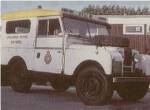 |
Series I |
The army got its own fleet of vehicles designation type FV18008 Ambulance 2-Stretcher 107". The rear body of the these vehicles was slightly modified, the height was reduced and the vehicle became shorter than the FV18005.
A 1956 vehicle was in service with the civilian Gwynedd Ambulance service until 1994. It was equipped with a railed stretcher frame in the rear, it was often used to transport medical staff during bad weather conditions.
Series II
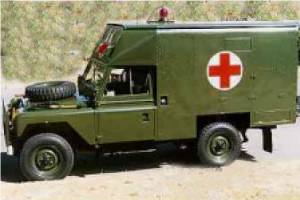 |
Australian Army SII |
The first of the British MOD Series II 109" ambulances were produced by Mickleover Transport, subsequent vehicles were produced by Marshall's of Cambridge, both were designated type FV18044.
The specification for these vehicles called for the height to be lowered from that of the Series I; this was to allow it to be flown inside RAF transport aircraft of the day. A distinctive chamfered lower rear body was introduced which gave increased departure angle to improve off-road mobility.
Like its predecessor's the vehicle was designed to carry either two stretcher patients or up to eight seated casualties and any medical attendants were shut in the back until the vehicle reached its destination.
Series IIa/III
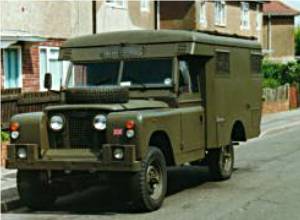 |
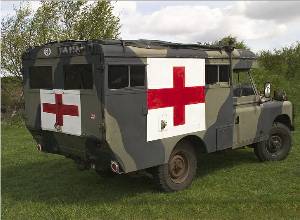 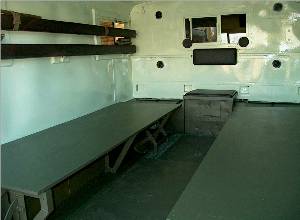 |
MOD Series IIa |
The second batch of vehicles produced from 1964 saw the introduction of 2 high level foldout rails; these were fitted to take a second pair of collapsed stretchers.
The Territorial Army were known to still be using Series IIa vehicles in as late as 1997. The Series III version, used the same body shell as the Series IIa both types continued in service side-by-side.
Make-shift ambulances were also utilised, both SWB and LWB GS vehicles were used as Forward Area Ambulances, these had two stretcher frames fitted over the rear cargo compartment, an extended canopy was used to cover the patients. These vehicles were only intended to be used to get casualties from front line areas to first aid posts or more suitable vehicles, Lightweight vehicles have also been used in this way.
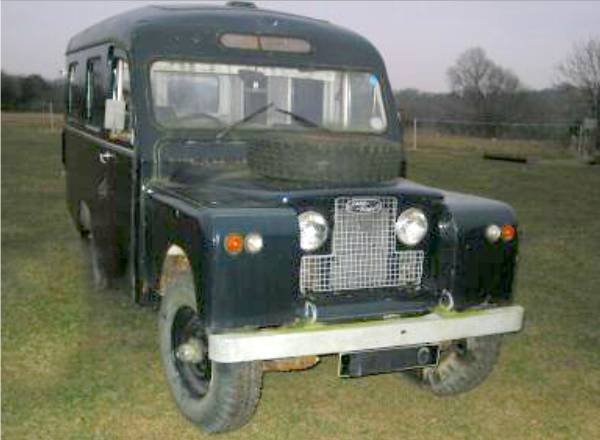 |
 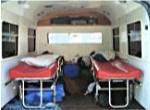 |
Lomas Ambulance |
Lomas Landrover based vehicles have a higher rounded shape above the cab and lack the chamfered lower rear body when compared to the Marshall vehicles. They were designed to carry 2 stretchers patients, also at least 1 FC prototype vehicle was produced which had been lengthened by Carmichael's.
Pictured here you can see the separate rear body of the vehicle when not fitted to a host vehicle.
Forward Control / 101 1-Tonne
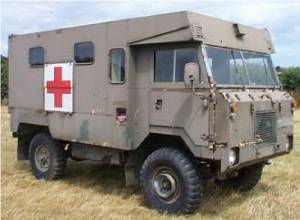 |
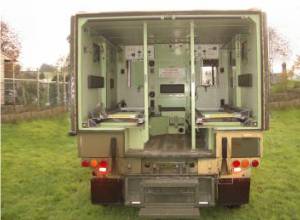 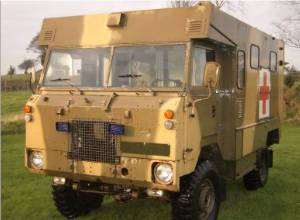 |
101-1 ton FC |
The shorter wheel based 101 1-tonne was introduced in 1975 and became very popular and much in demand in the ambulance role with the military. This vehicle could accommodate 4 stretchers and was equipped with a self-contained air purification system.
These vehicles complemented the more traditional Landrover ambulances, rather than replacing them. Prime users of this vehicle were the amphibious, airborne and airmobile brigades. The vehicles saw service in the Balkans with British peacekeepers and served long after the 127" vehicles were available.
Range Rover
 |
Range Rover |
If anyone can give me more information on the use of Range Rover ambulances please contact me.
90 & 110 / Defender
 |
  |
St John D110 |
The MOD ambulance fleet was now based on the 127" wheelbase. These vehicles were bigger, faster, more comfortable and more practical than their predecessors. It was almost possible for the attendant crew to stand upright in the back and access was now possible between the driver's cab and the rear of the vehicle.
A partially tinted window ran along the right side of the rear of the vehicle and large square tinted windows were set in each rear door. They were designed with a rear to accommodate three stretchers or to seat eight although the seating was still more realistically suitable for Six.
These vehicles were widely operated by the RAF and the Royal Navy although a small number served with specialist army units. Some Royal Navy vehicles had the rear compartments kited out to meet different specifications.
At least two batches of very similar vehicles, were produced based on the later Defender 130 (127") chassis. The two-piece angular front panel over the cab can be used to identify these vehicles from the earlier 90-110 vehicles.
Perentie
 |
Perentie |
All Perentie's are 6x6 with disc brakes all around, PAS and an Isuzu Turbo-Diesel engine on a 140" wheelbase. The rear axle's diff is offset to the left to allow any axle full wheel travel. They were built by Rover Jaguar Australia, based on the D110 they entered service with the Australian Army in 1986.
Pulse
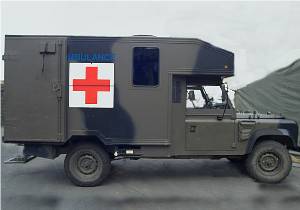 |
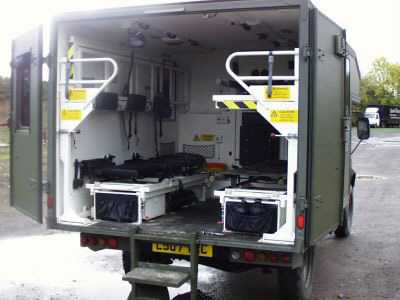  |
130XD Pulse |
The Dutch Marines were the first armed forces to take delivery of the vehicle closely followed by the MOD. The Pulse has now replaced all but a few of the 127" ambulances in British Army service. The vehicle will serve along side the 8000 Wolf's of the British MOD, the obvious inter-changeability of mechanical parts between very similar vehicles is an advantage to mechanics in the field.